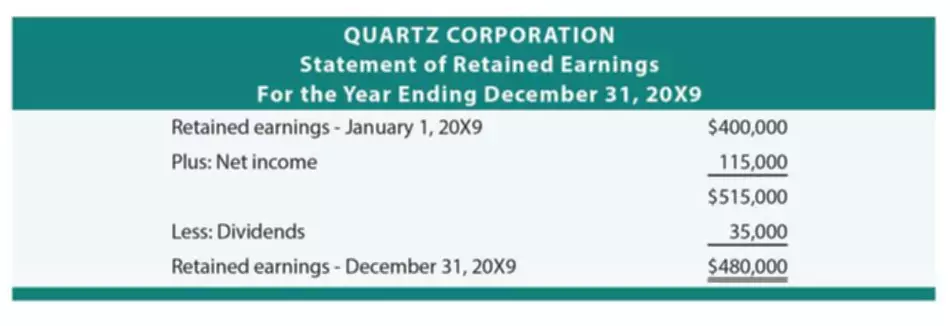Content

In this case, dividends can be paid out to stockholders, or extra cash might be put to use. At each reporting date, companies add net income to the retained earnings, net of any deductions. Dividends, which are a distribution of a company’s equity to the shareholders, are deducted from net income because the dividend reduces the amount of equity left in the company. Retained earningsare a portion of a company’s profit that is held or retained from net income at the end of a reporting period and saved for future use as shareholder’s equity. The retained earnings are calculated by adding net income to the previous term’s retained earnings and then subtracting any net dividend paid to the shareholders. Despite the role the board is supposed to play in guarding the shareholders’ interests, owners of stock in large, mature companies are fundamentally estranged from them and powerless to change them.
- Retained earnings are calculated to-date, meaning they accrue from one period to the next.
- Less mature companies need to retain more profit in shareholder’s equity for stability.
- Retained earnings are related to net income because it’s the net income amount saved by a company over time.
- Revenue on the income statement is often a focus for many stakeholders, but the impact of a company’s revenues affects the balance sheet.
- Since stock dividends are dividends given in the form of shares in place of cash, these lead to an increased number of shares outstanding for the company.
- Are you scouring the Internet for information on accounting and bookkeeping best practices for your company structure?
Rather, the stockholders ritually approve candidates management has selected. In this one-party system, the “elected” board subsequently receives from management a slate of officers, which it also ritualistically endorses. The results avoid any market aberrations in a particular year or those caused by market cycles. To do this, we selected many successive overlapping 5-year periods, 1970–1974, 1971–1975, and so on, concluding with 1980–1984. We averaged company profits for each 5-year period, thereby permitting comparison with shareholder enrichment over the same time. Good accounting software can help you create a statement of retained earnings for your business. Although this statement is pretty straightforward, additional information can be provided in the footnotes to the statement.
Revenue vs. Retained Earnings: What’s the Difference?
Although retained earnings are not themselves an asset, they can be used to purchase assets such as inventory, equipment, or other investments. Therefore, a company with a large retained earnings balance may be well-positioned to purchase new assets in the future or offer increased dividend payments to its shareholders. This figure, however, has no direct relation to a current shareholder’s initial investment or to that investment’s market value. The artifact “shareholders’ equity” was never intended to measure the investment, though it’s often cited as such by management, securities analysts, judges and juries, and investors themselves.

Instead, they reallocate a portion of the RE to common stock and additional paid-in capital accounts. This allocation does not impact the overall size of the company’s balance sheet, but it does decrease the value of stocks per share. It is calculated by subtracting all the costs of doing business from a company’s revenue. Those costs may include COGS and operating expenses such as mortgage payments, rent, utilities, payroll, and general costs. Other costs deducted from revenue to arrive at net income can include investment losses, debt interest payments, and taxes. Retained earnings refer to the historical profits earned by a company, minus any dividends it paid in the past. To get a better understanding of what retained earnings can tell you, the following options broadly cover all possible uses that a company can make of its surplus money.
Statement of retained earnings example
Revenue is the money generated by a company during a period but before operating expenses and overhead costs are deducted. In some industries, revenue is calledgross salesbecause the gross figure is calculated before any deductions. The income money can be distributed among the business owners in the form of dividends.
In more practical terms, retained earnings are the profits your company has earned to date, less any dividends or other distributions paid to investors. Even if you don’t have any investors, it’s a valuable tool for understanding your business. Retained earnings, also known as Accumulated Earnings or Accumulated Earnings and Profits, can be defined as a company’s accumulated surplus or profits after paying out the dividends to shareholders. Owner’s equity and retained earnings are largely synonymous in many circumstances, but there are key differences in exactly how they’re calculated. Many small businesses with just a few owners will prefer to use owner’s equity. Retained earnings are more useful for analyzing the financial strength of a corporation.
Retained earnings on balance sheet
https://www.bookstime.com/ is all net income which has not been used to pay cash dividends to shareholders. It appears in the equity section and shows how net income has increased shareholder value. A company is normally subject to a company tax on the net income of the company in a financial year. The amount added to retained earnings is generally the after tax net income. In most cases in most jurisdictions no tax is payable on the accumulated earnings retained by a company. However, this creates a potential for tax avoidance, because the corporate tax rate is usually lower than the higher marginal rates for some individual taxpayers. Higher income taxpayers could “park” income inside a private company instead of being paid out as a dividend and then taxed at the individual rates.
- Retained earnings resides on the balance sheet in the form of residual value of the company, while revenue resides on the income statement.
- She has nearly two decades of experience in the financial industry and as a financial instructor for industry professionals and individuals.
- If you’re looking to bring on new investors, retained earnings are a key part of your shareholder equity and book value.
- Financial statements are written records that convey the business activities and the financial performance of a company.
- During the same period, the total earnings per share was $13.61, while the total dividend paid out by the company was $3.38 per share.
- Retained earnings are a firm’s cumulative net earnings or profit after accounting for dividends.
Are you scouring the Internet for information on accounting and bookkeeping best practices for your company structure? Well, you’ve come to the right place, because this blog has subsidiary accounting info galore.
Financial Glossary
This article highlights what the term means, why it’s important, and how to calculate retained earnings. If the firm has good investment opportunity available then, they’ll invest the retained earnings and reduce the dividends or give no dividends at all. Equity consisted primarily of the common or preferred stock and the retained earnings of the company and is also referred to as capital. If you are a public limited company, then it is up to the board of directors to decide how and where the retained earnings should be reinvested. The goal of reinvesting retained earnings back into the business is to generate a return on that investment . Typically, businesses invest their retained earnings back into the business to pay for projects such as research and development, better equipment, new warehouses, and fixed asset purchases.
